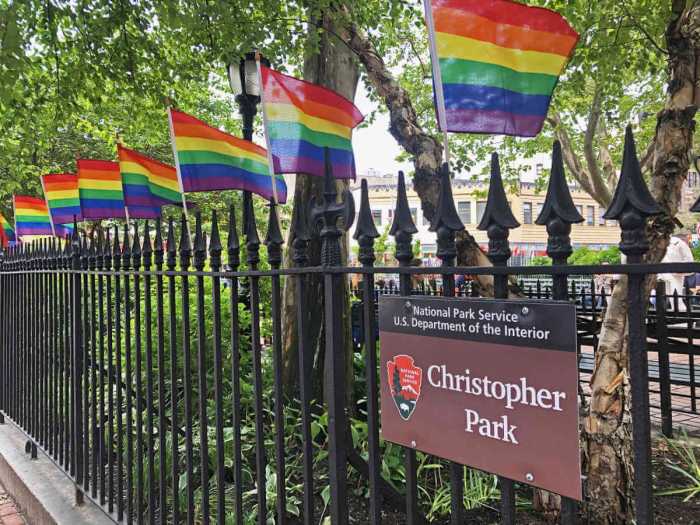Wild times in the ’70s; puppet mice steal “Cinderella;” “Ballet Russe” errata
Once upon a time, New York was a roiling sexual wonderland. The adventurous-minded could wake up on any given morning and wonder where the day would take them—East Side, West Side, Central Park Rambles, back room bars, bathhouses, porn theaters, the West Village piers, and––yes, it was all true––those infamous trucks.
These days, the streets are about all that’s left. With the ongoing targeting of gay fun spots like the baths and sex bars, and general tamping down of our sensual enjoyment, it almost seems about time for another uprising. New York, alas, is no longer Fun City, in the way that Los Angeles, Chicago, even Cleveland, and Indianapolis are.
To remind us of what we lost, filmmaker Joseph Lovett has produced “Gay Sex in the ‘70s,” a documentary which roughly covers that incredibly free period from the Stonewall Rebellion (1969) to the earliest reported AIDS cases (1981). Using fascinating film footage and flavorful reminiscences by era-survivors (Larry Kramer, Scott Bromley, Barton Benes, Rodger McFarlane, and more) he has created an absorbing portrait of a time in which gay men were all inventing themselves daily in an unchecked atmosphere of seemingly limitless sexual opportunity.
A special screening of the film was held at the terrific, under attended Museum of Sex on November 2, with a question and answer session afterwards involving Lovett, co-producer Michael Sean Kaminsky, and a bubbly Dr. June Reinisch, former director of The Kinsey Institute. The diverse audience ranged from 90-year-old restaurateur Johnny Nicholson, who remembered how gays partied in the ‘30s with 15 cent marijuana joints, to a gay 20-something announcing he had never heard of Stonewall before!
I differed with Lovett in my remembrance of heterosexual attitudes toward all this gay licentiousness. Lovett, then a closeted TV producer at ABC, said his active sex life was something he never dreamed of sharing with his straight friends. But I recall how, in those days, even though being gay may have been less universally accepted than it may be today, there seemed to be far less of a schism between straight and gay, with heterosexuals utterly fascinated and bemused by our carrying-on. The movie “Cabaret” had made bisexuality chic, everybody wanted to get into Studio 54, and many straights, with their own guilt-free dabbling in bisexuality and group encounters, loved hearing about what the “boys” were up to with a warm sense of exploratory camaraderie.
The party, of course, came to a halt with AIDS, although it was anything but abrupt, with some gays continuing to party on even after knowledge about the disease became widespread, trips to the Chelsea free clinic for STD treatment remaining as blithely routine as ever. Far too many in an entire generation of gay men was wiped out, a fact made chillingly clear by Lovett’s reminiscence of a hot Fire Island Party. All of the guests have died, save him and his partner.
Rodgers and Hammerstein’s “Cinderella” (at the Paper Mill Playhouse in Millburn, New Jersey, through December 4––tickets at 973-376-4343) has a pair of charming leads in the persons of Angela Gaynor and Paolo Montalban as Cinders and her Prince, but the show is stolen by a bunch of singing puppet mice. The cornball device, more Disney than anything else, actually pumps some disarmingly silly freshness into the show, certainly more than the hideous, “hip” updating of the book which has Cinderella being described as “a bad mama jamma,” and Gabriele Barre’s tacky direction—particularly as regards the two anachronistically grotesque-in-every-sense stepsisters.

Still, this production is far superior to the recent star-studded but abysmal City Opera revival, with the transformation scene having way more real magic to it, thanks to some flashy pyrotechnics and the best quick change stunt I have ever seen onstage. Local Jersey light Suzzanne Douglas made a snappy, glamorous Fairy Godmother and, I heard, was just as giving offstage, buying meals for the entire cast during rehearsals. At the after-party, I asked Montalban what it was like recreating the Prince after doing it on TV with Brandy some ten years ago. “It was strange at first,” he said, “but then pretty wonderful. And it was only four years ago.” Dude! I checked it out and you did it in 1997!
Film Forum’s showing of the documentary “Ballets Russes” is drawing deserving crowds for its splendid portrait of a dance era of unparalleled creativity and glamour, but producer Douglas Blair Turnbaugh, an eminent dance historian, sent me a communiqué, addressing what he feels are certain errors that made it into the film’s final cut. They concern dancer Nina Novak who, in the film, is referred to as chorus dancer with whom Sergei Denham, the company director, fell in love. Turnbaugh said, “Novak was not a chorus girl—she had joined the company as a soloist. Further negative remarks by the narrator lead the viewer to believe that the Ballet Russe was ruined … because of Miss Novak’s presence. This was not the case, and on contrary, she filled a vital role and was a favorite ballerina through the USA for more than a decade.”
Another mistake, Turnbaugh felt, concerned the scandal of the curtain coming down early during a performance of “Gaiete Parisienne” before the end of the piece—“The anti-Denham myth [which dancer Frederick Franklin repeats in the film] has finally been put right by a statement from Thatcher Clarke. Clarke was the dancers’ union representative, and it was on the union’s order, delivered by Clarke, that the curtain was brought down early. In the intervening four decades, Mr. Clarke obviously regrets that Mr. Denham was erroneously blamed for the incident – he reports that this scandal ‘nearly killed Mr. Denham’ and he decided to put the record straight.”
Contact David Noh at Inthenoh@aol.com.
gaycitynews.com




































